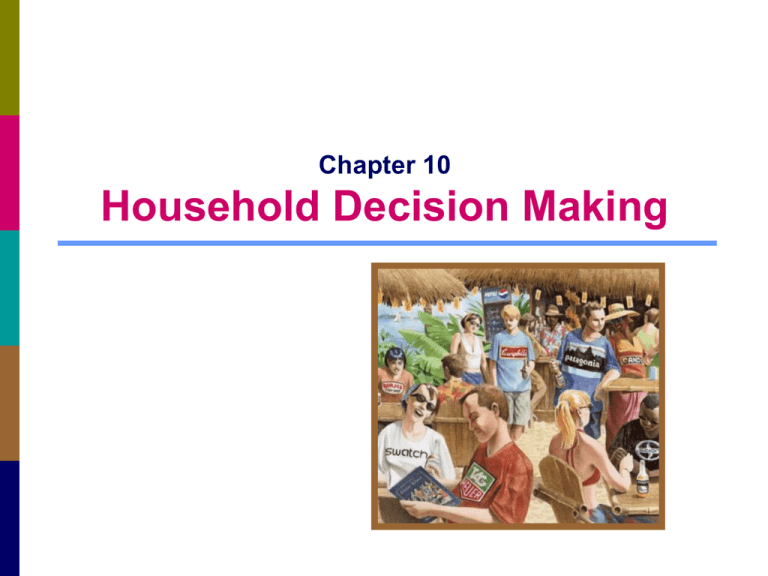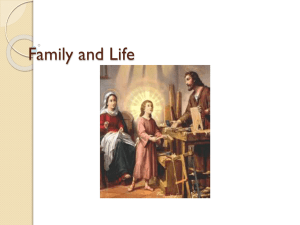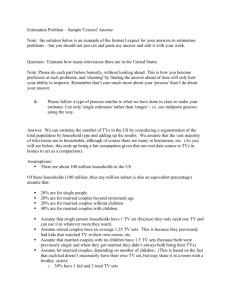
Chapter 10
Household Decision Making
Decision Roles
In collective decisions, one may play any (or all) of the
following roles:
• Initiator: bring up idea or identifies need
• Gatekeeper: conducts information search and
“presents” information to other decision-makers
• Influencer: sways outcome of decision
• Buyer: actually makes the purchase
• User: winds up using product
12-2
The Modern Family
• Before 1900s: extended family
• 1950s: nuclear family (mother, father, and
children)
• Today:
• Married couples constitute less than
•
•
•
•
50% of households
Majority of adult women live without
spouse
Unmarried opposite sex couples (cohabitation) is 10-15% of all couples
Same-sex couples
Friends, workers and SM/Web are the
“new family”
12-3
Family Size
• Depends on educational level, availability of birth
control, and religious influences
• Marketers keep an eye on fertility and birth rates
• Worldwide, women want smaller families (especially
in industrialized countries)
• Contraception/abortion are more readily available
• Divorce is more common
• Older people now pursue “non-grandchildren”
activities (i.e. travel, education, work)
• Some countries want people to have more
children (Europe)
12-4
Sandwich Generation
• Sandwich generation:
middle-aged adults who care
for their parents as well as
their own children
• Boomerang kids: adult
children who return to live
with their parents
• Roommates and “failedrelationship” kids are most
likely to boomerang
• Spend less on household items
and more on entertainment
12-5
Pets as Family Members
•
•
•
•
Pets are treated like family members
Spending on pets has doubled in the last decade
Pet Owner Psychology and Characteristics
Pet-smart marketing strategies:
• Name-brand pet products
• Designer water for dogs
• Lavish kennel clubs, gyms, pet classes/clothiers
• Pet accessories in cars
• Pet Therapists
12-6
Family Life Cycle
• Factors that determine how couples spend money:
• Whether they have children
• Age of children; whether at home or
•
•
•
emancipated
Whether the partner works
Family Lifestyles and attitudes towards money
Life Stage of family members
12-7
Life-Cycle Effects on Buying
Life Cycle stages can show marked differences in consumption
patterns:
• Young bachelors and newlyweds: exercise, go to
bars/concerts/movies
•
•
•
•
•
Early 20s: apparel, electronics, gas expenditures high
Families with young children: health foods
Single parents/older children: junk foods
Newlyweds and New Home Owners: appliances, furniture
Older couples/bachelors: home maintenance/re-modeling
services, travel, “edutainment”, insurance
12-8
Household Decisions
Families make two types of decisions:
• Consensual purchase decisions: members agree on
the desired purchase, perhaps differing only in terms
of how it will be achieved
• Accommodative purchase decision: members have
different preferences or priorities and they cannot
agree on a purchase to satisfy the minimum
expectations of all involved
• Frequently result in multi-laterally unwanted
compromises or no decision at all
12-9
Household Decisions (cont.)
Specific factors that
determine how much
family decision conflict
there will be when making
“joint” decisions:
• Interpersonal need
• Product involvement and
utility
• Responsibility for
ownership and/or payment
• Relationship power
12-10
Sex Roles and Decision-making
Responsibilities
Who makes key decisions in a family?
• Autonomic decisions: when one family member
makes decisions for the family
• Wives still make decisions on groceries, toys,
clothes, and medicines
• Syncretic decisions: when both partners “jointly”
make decisions
• Typically happens with cars, vacations, homes,
appliances, furniture, home electronics, interior
design, phone service
• Increases with education and household income
increases
12-11
Identifying the Decision Maker
“Family Financial Officer (FFO)”
• Traditional family norm: the man makes the money
and the woman spends it
• Modern family norm: either partner can make
money; either partner can spend money
Four factors in joint versus sole decision making:
•
•
•
•
Adherence to sex-role stereotypes
Comparative spousal resources
Experience with purchase
Socioeconomic status
12-12
LeoShe Mother Types
• June Cleaver: traditional, stay-at-home mom
• Tug of War: work but not happy about it
• Strong Shoulders: lower income but optimistic
and strong
• Mother of Invention: enjoy working and being
mothers
12-13
Heuristics in Joint Decision Making
• Synoptic Ideal: Husband and wife take a common
view and act as joint decision makers
• Heuristics simplify or encourage decision making:
• Agree on salient, objective dimensions; different
•
•
opinions on less salient/objective dimensions
Task specialization
Concessions based on intensity of each spouse’s
preferences (bargaining process)
• Trade away lower value outcomes for higher
value outcomes
12-14
Children as Decision Makers
Children make up three distinct markets:
• Primary market: kids spend their own money
• Influence market: parents buy what their kids tell
them to buy (parental yielding)
• Future market: kids “grow up” quickly and purchase
items that normally adults purchase (smartphones,
laundry detergent)
12-15
Consumer Socialization
• Consumer socialization: process by which young
people acquire skills, knowledge, and attitudes
relevant to their functioning in the marketplace
• Occurs at different rates in different cultures
• Children’s purchasing behavior is influenced by:
• Parents
• Television and web (“electronic babysitters”)
• Sex roles
• Peers
• Teachers
12-16
Cognitive Development
• Marketers segment children by their stage of
Cognitive Development
• ability to comprehend concepts of increasing
complexity
• Three segments often used today:
• Limited: Below age 6, children do not use
•
•
storage and retrieval strategies
Cued: Between ages 6 and 12, children use these
strategies, but only when prompted
Strategic: Children age 12 and older
spontaneously employ storage and retrieval
strategies
12-17
Five Stages of Consumer Development
Parental Styles for Socializing Children
Authoritarian
Neglecting
Indulgent
Marketing Research and Children
• Kids tend to:
• Be undependable reporters of own behavior
• Have poor recall
• Be flippant
• Be overly influenced by other kids
• Not understand abstract questions












